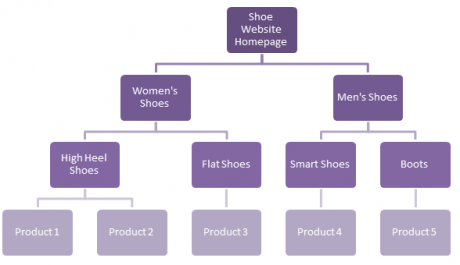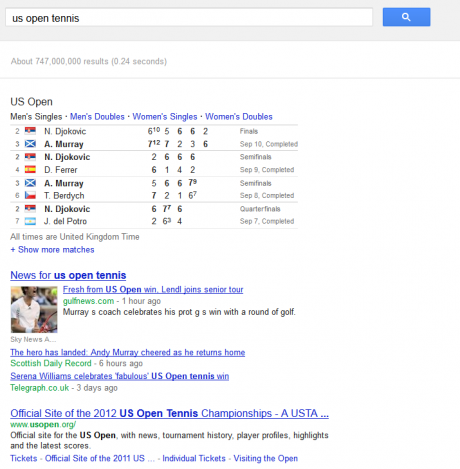The Importance of Website Hierarchy for SEO
Hierarchy is defined as a system where things of greater importance are ranked more highly than things of lesser importance. People naturally think in terms of hierarchy, something is always more important than something else, whether you are making a to-do list, creating a table plan or making arrangements for the weekend.
Website Hierarchy
People naturally navigate websites using a hierarchy through the site’s navigation:  However, search engines do not necessarily see that hierarchy if it is not reflected in the url structure, or the site’s breadcrumbs.
However, search engines do not necessarily see that hierarchy if it is not reflected in the url structure, or the site’s breadcrumbs.
URL Structure
The logical url structure for the above website, and a way of conveying the site’s hierarchy to search engines, would be through the following url structure:
- www.ashoewebsite.com
- www.ashoewebsite.com/womens-shoes
- www.ashoewebsite.com/womens-shoes/high-heels
- www.ashoewebsite.com/womens-shoes/high-heels/product-1
- www.ashoewebsite.com/mens-shoes
- www.ashoewebsite.com/mens-shoes/boots
- www.ashoewebsite.com/mens-shoes/boots/product-5
This is also another way of communicating to the user what the product is, for example www.ashoewebsite.com/mens-shoes/boots/product-5 tells the user that they are going to see a pair of men’s boots. www.ashoewebsite.com/product-5 tells the user that they are going to see a product on a shoe website. This url structure is also more SEO friendly as it includes the different keyword variations that you want to optimise the page for; ‘product 5’, ‘product 5 boots’, ‘men’s product 5 boots’, ‘men’s boots product 5’.
Why Now?
On 10th August Google posted the 86 search quality highlights that had been implemented in June and July. This included the following points, which appear to have contributed to website hierarchy becoming even more important.
Google Freshness Update
“Lime. [project codename “Freshness”] This change improves the interaction between various search components to improve search results for searches looking for fresh content.” “rrfix4. [project codename “Freshness”] This is a bug fix to a freshness algorithm. This change turns off a freshness algorithm component in certain cases when it should not be affecting the results.” These changes relate to the Google Freshness Update which was first released in November 2011. The Google Freshness Update was all about Google serving the latest content relating to a search term where time-sensitive content could be relevant. For example, a search for ‘US Open Tennis’ generates the following results:
Gulfnews.com outranks the official US Open Tennis website because it has published relevant content recently, within the last hour. The Lime update above was a refresh of the Google Freshness system which means that the system which gives precedence to new content was updated. The subsequent rrfix4 update suggests that the refreshed Freshness algorithm was affecting searches that it should not have, such as normal webpages. So, how does this relate to url structure and hierarchy? Well, if urls do not have hierarchy then they appear to search engines to be of equal authority. So: www.ashoewebsite.com/womens-shoes has exactly the same authority as www.ashoewebsite.co.uk/product-2 . This means despite my very careful optimisation and promotion of www.ashoewebsite.com/womens-shoes if I launch a new product with the url www.ashoewebsite.co.uk/product-6-shoes there is a chance that my new product page will knock my /womens-shoes category page out of the search results, because the newer page is new and on an equal level of importance to the top level category page. The new product page will then move down in the rankings, because it is not the best page for someone searching for ‘women’s shoes’, but my /womens-shoes category page will not necessarily move back up in the search results, now that it has been knocked out. In other words: Google Freshness + no hierarchy = inconsistent rankings and bad times
Site Hierarchies in Search Results
“#80568. [project codename “Snippets”] This change improves our algorithm for generating site hierarchies for display in search result snippets.” This is where Google displays the site hierarchy in the search results, even if it is not in the url. So if your site pulls in the breadcrumbs for the stages a user would go through to reach a page, even if it is not reflected in the url, search engines can still the hierarchy (the green url below the Page Title 'www.ticketsnow.com > Sports Tickets > Tennis Tickets'):  The url of the page is: http://www.ticketsnow.com/us-open-tennis-tickets/ (no hierarchy) The breadcrumbs are still displayed on the page, even though they aren’t in the url and the user did not follow that journey to reach the page:
The url of the page is: http://www.ticketsnow.com/us-open-tennis-tickets/ (no hierarchy) The breadcrumbs are still displayed on the page, even though they aren’t in the url and the user did not follow that journey to reach the page:  The above update, #80568, shows that Google have been refining this system and therefore looking further into site hierarchies when looking at where to rank pages.
The above update, #80568, shows that Google have been refining this system and therefore looking further into site hierarchies when looking at where to rank pages.
What to do?
There are two options for you here:
- Change the url structure convention on your website to reflect the hierarchy of the site. However, changing urls can be very risky, if you take this route then SEO migration is essential. You should also test the process on a small section of the site, before rolling it out across the board.
- Add hierarchical breadcrumbs to the site. There are lots of ways to implement breadcrumbs on a website, depending on the platform. But the key is that they reflect the site’s hierarchy not the user journey to that point.
If you want to keep up to date with content strategy trends and digital marketing innovations then keep an eye on my contributions to the blog.


